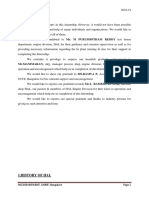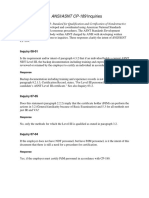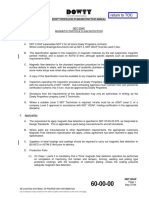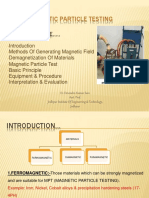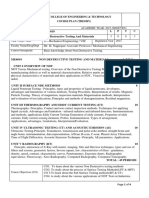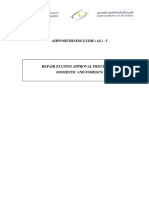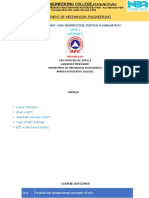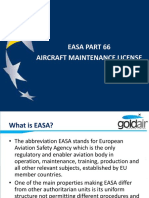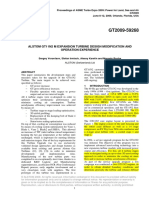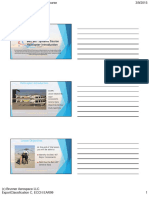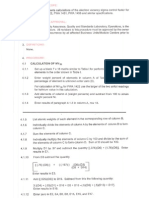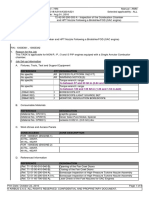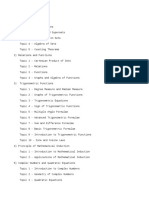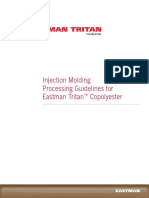Ae2355 Manual
Ae2355 Manual
Uploaded by
Natesan MahendranCopyright:
Available Formats
Ae2355 Manual
Ae2355 Manual
Uploaded by
Natesan MahendranOriginal Description:
Copyright
Available Formats
Share this document
Did you find this document useful?
Is this content inappropriate?
Copyright:
Available Formats
Ae2355 Manual
Ae2355 Manual
Uploaded by
Natesan MahendranCopyright:
Available Formats
www.Vidyarthiplus.
com
TABLE OF CONTENTS
AE 2355
AERO ENGINE LABORATORY MANUAL
Expt
LIST OF EXPERIMENTS
Page no
Introduction piston engine
1
Stripping of a piston engine
Engine (Piston Engine) - cleaning, visual inspection, NDT checks.
Piston Engine Components - dimensional checks.
Piston Engine reassembly.
Propeller Pitch Setting
Introduction jet engine
6
Stripping of a jet engine
Jet Engine identification of components & defects.
Jet Engine NDT checks and dimensional checks
Jet Engine reassembly.
10
Engine starting procedures.
PREPARED BY
S.RAJKUMAR
Page 2
www.Vidyarthiplus.com
www.Vidyarthiplus.com
Issue No: 01
SRINIVASAN ENGINEERING COLLEGE,
Revision No: 00
PERAMBALUR 621 212
DEPARTMENT OF AERONAUTICAL ENGINEERING Date :
AERO ENGINE LAB
INTRODUCTION PISTON ENGINE
Piston engines are internal combustion engines that burn a mixture of fuel and air inside a
combustion chamber. The chamber is provided with a piston that moves within the compression
chamber. The energy for the movement of the piston is provided by the air-fuel mixture. Piston
engines operate similar to the car and other automobile engines. In its basic operation, a valve in
the engine permits air into the chamber (called the cylinder) which is compressed by the moving
piston. When an appropriate compression is reached, fuel is allowed into the compressed air
through another inlet as a fine spray. Finally, the compressed fuel-air mixture is ignited with a
spark provided by a spark plug, which causes the mixture to explode violently. The explosive
power is used to move the piston back, and remove the exhaust gases from the compression
chamber. The return movement of the piston is conveyed to the wheel and fans of the aircraft
which causes it to rotate at high speed. In a propeller powered aircraft, much of the thrust is
created by the propellers, which creates the upward lift for the aircraft.
The general aircraft piston engine used for thrust generation, consist of the following basic
components.
CRANK CASE:
The crank case of an engine is the housing that houses the various components
surrounding the crankshaft. Therefore it is the basic foundation of the engine. The crank case
performs the following functions:
It contains bearings in which crankshaft revolves.
It provides a tight enclosure for lubricating oil.
It supports various internal and external mechanism of power plant
It provides a support for attachment of cylinder.
It prevents the misalignment of the shaft and its bearings.
BEARINGS:
Bearing is any surface that supports or is supported by another surface. The bearings in
any aircraft engine are designed to minimize the friction and wear resistance. They must reduce
the friction of moving parts and also take the thrust loads, radial loads or combination of both.
PREPARED BY
S.RAJKUMAR
Page 3
www.Vidyarthiplus.com
www.Vidyarthiplus.com
CRANK SHAFT:
The crankshaft transforms the reciprocating motion of the piston to rotating motion for
turning the propeller. It is a shaft composed of one or more cranks located at definite places
between the end. Since the crank shaft is the backbone of the engine it is subjected to all forces
developed within the engine and hence should be strongly constructed.
CONNECTING ROD ASSEMBLIES:
Connecting rod is the link which transmits forces between the piston and crankshaft of an
engine. It transmits the reciprocating motion of the piston to the rotating movement of the crank
shaft. The principle type of connecting assemblies are the
Plain type
Fork and handle type
Articulated type
PISTON:
The piston is a plunger that moves back and forth or up and down within the engine
cylinder barrel. It transmits the force of the burning and expanding gases in the cylinder through
the connecting rod to the engine crank shaft. As the piston moves down the cylinder, during
intake stroke, it draws in the air fuel mixture. As it moves up, it compreses the charge. Ignition
takes place and the expanding gases cause the piston to move towards the crank shaft.The piston
forces the burnt gases out of the combustion chamber during the next stroke.
CYLINDERS:
The cylinder of an IC engine converts chemical heat energy of the fulel to mechanical
energy and transmits it through the connecting rods to the rotating crank shaft. The cylinder
assembly used for present day engines usually includes cylinder barrel, cylinder head, valve grid,
valve seats, rocker arms, cooking fins
VALVES:
In general a valve is a device for regulating or determining the check on the flow of a
liquid or a gas by a movable part which opens or closes into a passage.The main purpose of a
valve in IC engine is to open and close parts which are into the combustion chamber of the
engine namely intake and exhaust ports.The valves are associated with valve guides,valve seats
and valve springs.
PREPARED BY
S.RAJKUMAR
Page 4
www.Vidyarthiplus.com
www.Vidyarthiplus.com
PROPELLERS:
They are essential aircraft parts that provide the necessary thrust for moving the aircraft.
The propeller is connected to the engine by means of a shaft.The propeller consists of two or
more blades and a central hub to which the blades are attached service. For an aircraft to remain
in an airworthy condition the following conditions have to be fulfilled.
Periodic inspection
Repairs
Overhauls and replacements
PREPARED BY
S.RAJKUMAR
Page 5
www.Vidyarthiplus.com
www.Vidyarthiplus.com
Issue No: 01
SRINIVASAN ENGINEERING COLLEGE,
Revision No: 00
PERAMBALUR 621 212
DEPARTMENT OF AERONAUTICAL ENGINEERING Date :
AERO ENGINE LAB
EX. NO:1
STRIPPING OF PISTON ENGINE
AIM:
To dismantle a piston engine and study its particular components.
TOOLS REQUIRED:
Special tools for notching crank shaft.
Universal socket for spark plug
Selected spanner no: 6-19
Ring spanner no: 6-22
Adjustable spanner
Plier, cutter and screwdriver
Value depression tool
Crow foot spanner
Simple aircraft piston engine
PROCEDURE:
1. Remove spark plug and rocker curves.
2. Remove starter and accessories.
3. Turn the engine over such that cylinders are upper most.
PREPARED BY
S.RAJKUMAR
Page 6
www.Vidyarthiplus.com
www.Vidyarthiplus.com
4. Remove controls completely with universal joints.
5. Remove air scoop, plug leads, distribution covers.
6. Remove induction system with carburetor.
7. Unscrew push rod ball socket from rockers.
8. Take out push rod and push rod covers.
9. Remove cylinder baffle plate.
10. Remove cylinder.
11. Remove piston rings.
12. Extract gudgeon pin, air clip.
13. Withdraw gudgeon pin and piston. Remove magnetos.
14. Remove gearbox with timing gear cover.
15. Turn the engine cover on its stand. Remove starter.
16. Remove adaptor, thrust bearing cover and top cover.
17. Detach big and bearing caps. Withdraw connecting rod.
18. Remove main, intermediate bearing caps.
19. Lift crankshaft. Unscrew idle gear hub bolt.
20. Draw off gear wheel. Remove magneto drivers.
21. Unscrew camshaft gagging the gear.
22. Remove camshaft rear bearing bush.
23. Withdraw camshaft. Remove tappet and guides.
24. The parts are kept for visual inspection.
RESULT:
Thus the stripping of piston engine is carried according to instructions in the
manufacturers maintenance manual.
VIVA QUESTIONS:
Explain overhaul
What are the safety precautions while handling the engine?
Explain the purpose of push rod
What is the role of cam shaft
PREPARED BY
S.RAJKUMAR
Page 7
www.Vidyarthiplus.com
www.Vidyarthiplus.com
Issue No: 01
SRINIVASAN ENGINEERING COLLEGE,
Revision No: 00
PERAMBALUR 621 212
DEPARTMENT OF AERONAUTICAL ENGINEERING Date :
AERO ENGINE LAB
EX. NO:2
NDT CHECK FOR AIRCRAFT COMPONENTS
AIM:
To perform the NDT checks on aircraft components
APPARATUS REQUIRED:
Aircraft component
Kerosene
Lubricating oil
French chalk
Methylated spirit
Heating source
PROCEDURE:
I. For parts that can be removed from aircraft
a) For these components, hot fluid chalk method is used cleaning must be done
b) A mixture of three parts of kerosene and one part of lubricating oil is heated at 90 95oC.
c) The removal components such as pistons connection rods, cylinders, combustion
chamber are dipped in the hot fluid
d) Take the component out and dried out apply French chalk on it.
e) Extra French chalk is to be removed by tapping.
f) Then cool the component, the contraction of the piston on cooling will force the oil out of
any crank and stain the French chalk with a yellowish color.
II. For components that cannot be removed from aircraft.
a) For a components that cannot be removed from aircraft such as landing gear mounting,
cold fluid chalk method is used cleaning is done.
PREPARED BY
S.RAJKUMAR
Page 8
www.Vidyarthiplus.com
www.Vidyarthiplus.com
b) French chalk is mixed with Methylated spirit and applied on the components that are to
be checked
c) Excess chalk is removed by tapping.
d) Methylated spirit will evaporate off leaving the cracks stain with French chalk
RESULT:
Thus the NDT checks have been performed on aircraft component.
VIVA QUESTIONS:
What are the NDT techniques used in inspection?
What techniques is used for inspecting internal defect
Explain some defects occur in piston engine components?
How to monitor the health of engine condition?
PREPARED BY
S.RAJKUMAR
Page 9
www.Vidyarthiplus.com
www.Vidyarthiplus.com
Issue No: 01
SRINIVASAN ENGINEERING COLLEGE,
Revision No: 00
PERAMBALUR 621 212
DEPARTMENT OF AERONAUTICAL ENGINEERING Date :
AERO ENGINE LAB
EX. NO:3
PISTON ENGINE COMPONENTS - DIMENSIONAL CHECKS.
3.(a) VIEWING PROCEDURE OF CONNECTING ROD
AIM:
To perform maintenance and inspection on connecting rod.
TOOLS REQUIRED:
Surface plate
Micrometer
Dial gauge
Vernier caliper
Telescopic gauge
Tapered sleeve
Arbors
Plug gauge
PROCEDURE:
1. Check the connecting rod conditions,the big end caps for cracks and other surface defects
by hot oil and chalk method.
2. Check the rod for notches and abrasion.
3. Measure small end dia and compare with external dia of gudgeon pin.
4. Check the nip in the big end bearings.
5. Measure and check the diameter with internal dimensions of cylinder bore gauge.
6. To carry out the nip check,assemble connecting rod shell and cap as per assembly
sequence and tighten the bolts.
7. Tighten to 840 pounds inch and check diameter of big end bearing.
8. Check connecting rod for alignment.
9. Check connecting rod bolts for elongation and nuts for threads.
10. Check for hardness.
RECTIFICATION:
1. During the NIP check, if 0.004 doesnt go inside machine the big end cap. If 0.006
goes inside replace the bearing cap.
PREPARED BY
S.RAJKUMAR
Page 10
www.Vidyarthiplus.com
www.Vidyarthiplus.com
2. Fitting and searing can be removed by stoning and polishing if not too deep.
RESULT:
Thus the connecting rod is viewed and its dimensions are measured as per instructions
in the manufacturers maintenance manual.
VIVA QUESTIONS:
Which type of material used to manufacture the connecting rod?
Different types of connecting rod?
What refer the big and small ends of connecting rod?
What is connecting rod?
PREPARED BY
S.RAJKUMAR
Page 11
www.Vidyarthiplus.com
www.Vidyarthiplus.com
Issue No: 01
SRINIVASAN ENGINEERING COLLEGE,
Revision No: 00
PERAMBALUR 621 212
DEPARTMENT OF AERONAUTICAL ENGINEERING Date :
AERO ENGINE LAB
3.(b) VIEWING PROCEDURE OF CRANK SHAFT
AIM:
To view the crankshaft and check out its dimensions.
TOOLS REQUIRED:
Surface table
V-blocks
Dial indicator
Vernier caliper
Micrometer
Magnifying glass
PROCEDURE:
1. Check for cracks by contact current method.
2. Check for corrosion, pitting etc..
3. Check for ovality and taperness using micrometer.
4. Check external dimensions of crank pin and journals.
5. Carry out rip check before measuring internal dimensions.
6. Check for central journal errors due to ovality.
7. Check the crank web for parallelism.
8. Check crank pin for parallelism. Error allowed is 0.0016 per unit length.
9. Check if propeller shaft has a tapered end in the hub.
10. Check propeller shaft for threads and keyways for burrs and beveling.
11. Check oil seal retainer and sealing for burrs and correct seating.
12. Carry out static and dynamic hardness tests.
RECTIFICATION:
1. Score, taper and ovality can be removed by grinding.
2. Slight score and pitting can be removed by grinding or dressing with carborundum or
polishing with emery paper.
PREPARED BY
S.RAJKUMAR
Page 12
www.Vidyarthiplus.com
www.Vidyarthiplus.com
RESULT:
Thus the crankshaft is viewed and its dimensions are checked with the manufacturers
maintenance manual.
VIVA QUESTIONS:
What is the purpose of crankshaft?
What is a journal?
What is the purpose of counter weight?
PREPARED BY
S.RAJKUMAR
Page 13
www.Vidyarthiplus.com
www.Vidyarthiplus.com
Issue No: 01
SRINIVASAN ENGINEERING COLLEGE,
Revision No: 00
PERAMBALUR 621 212
DEPARTMENT OF AERONAUTICAL ENGINEERING Date :
AERO ENGINE LAB
3.(c) VIEWING PROCEDURE OF CYLINDER ASSEMBLY
AIM:
To perform the task of maintenance and inspection of cylinder assembly.
TOOLS REQUIRED:
DIP basket
Stud removing tool
Spark plug insert tool
Hand vice drill bit
Drift and bore gauge
PROCEDURE:
CLEANING:
Clean the cylinder head with petroleum solvent. Dip it in petroleum agent using
cleaning basket.
VISUAL INSPECTION:
1. Inspect the cylinder head visually using a magnifying glass.
2. Inspect the cylinder for
3. Loose damaged studs.(replace new ones)
4. Loose spark plug (insert new oversize ones.)
5. Loose cracked valve guide.
6. Damaged mounting ports, rocker box cover
7. Cracked or damaged fins
DIMENSIONAL CHECKS:
1. Check internal dimensions of intake and exhaust valves.
2. Check diameter and roundness of guide bore with gauge.
3. Check wear and tear in rocker arm bush.
4. Dimension checks are done in processes.
PREPARED BY
S.RAJKUMAR
Page 14
www.Vidyarthiplus.com
www.Vidyarthiplus.com
CYLINDER BARREL:
TOOLS REQUIRED:
Cleaning basket
Feeler gauge
Dial gauge
Bore gauge
PROCEDURE:
CLEANING:
Clean the barrel using petroleum solvent dipping it on the cleaning basket.
VISUAL INSPECTIONS:
1. In cooling fins, check for nicks and notches.
2. In barrel, check for cracks (result in rejection)
3. In skirt, check for cracks, bends, and breaks.
4. In mounting flange, check for nicks, cracks and warping.
5. Inside the barrel inspect for corrosion and scoring.
DIMENSIONAL CHECKS:
1. Maximum clearance between piston skirt and cylinder is 0.021
2. Maximum taper of cylinder wall in 0.018.
3. Maximum ovality is 0.018.
RESULT:
Thus the inspection of the cylinder assembly is carried out as per instructions given in
manufacturers maintenance manual.
VIVA QUESTIONS:
What is cylinder head temperature?
Why fins are used?
What is cold spark plug?
PREPARED BY
S.RAJKUMAR
Page 15
www.Vidyarthiplus.com
www.Vidyarthiplus.com
Issue No: 01
SRINIVASAN ENGINEERING COLLEGE,
Revision No: 00
PERAMBALUR 621 212
DEPARTMENT OF AERONAUTICAL ENGINEERING Date :
AERO ENGINE LAB
3.(d) VIEWING PROCEDURE OF PISTON ASSEMBLY
AIM:
To carry out inspection on the piston assembly.
TOOLS REQUIRED:
Cleaning basket
Feeler gauge
Scale 12
Telescopic gauge
Micrometer
Vernier caliper
PROCEDURE:
1. Check for completeness of the piston assembly and clean it by dipping in petroleum
solvent using cleaning basket.
2. Examine the piston surface thoroughly for excessive pitting, cavaties or surface
distortion.
3. Check the piston rings, grooves, piston pinholes and holes base for any damage.
4. Check side clearance between piston rings and piston (0.004-0.0025).
5. Check end clearance on wedge type piston rings.
6. Check inside diameter of piston pinhole (0.03-0.004).
7. Check clearance between piston skit and cylinder and piston dia top and bottom(0.021).
8. Check outside diameter of piston pin against inside diameter of hole in piston(0.00020.001).
9. Measure fit between piston and plug and check outside diameter of plugs(0.00020.001).
10. Examine two interior surface of piston pin hole for corrosion and fitting.
RESULT:
The maintenance and inspection of the piston assembly has been performed according
to manufacturers maintenance manual.
PREPARED BY
S.RAJKUMAR
Page 16
www.Vidyarthiplus.com
www.Vidyarthiplus.com
VIVA QUESTION:
What is manufacturers maintenance manual?
Explain the piston types?
Why piston rings are used?
What is meant by clearance?
What types of rings are used?
PREPARED BY
S.RAJKUMAR
Page 17
www.Vidyarthiplus.com
www.Vidyarthiplus.com
Issue No: 01
SRINIVASAN ENGINEERING COLLEGE,
Revision No: 00
PERAMBALUR 621 212
DEPARTMENT OF AERONAUTICAL ENGINEERING Date :
AERO ENGINE LAB
EX. NO: 4
REASSEMBLY OF PISTON ENGINE
AIM:
To reassemble the piston engine after inspection checks.
TOOLS REQUIRED:
Special universal socket for spark plug
Set spanners 6-19
Ring spanners 6-22
Adjustable spanner
Pliers and cutters
Screwdriver different sizes
Hammer
Value depression tool
Crow foot spanner
PROCEDURE:
1. Insert the tappet and the guides in the crank case.
2. Fix the camshaft after positioning bearing bush.
3. Fix the magneto drive gear.
4. Fix the idle gear and screw the hub bolt.
5. Fix the crankshaft and position the bearing caps.
6. Fix the connecting rod and the bearing caps.
7. Position the top crankcase and then tighten all bolts and nuts.
8. Fix the gearbox with timing gear cover.
9. Fix the magnetos.
10. Fix the position in the connecting rod.
11. Assemble the piston rings on the piston groove and insert the cylinder over piston and
tighten all cylinder large nuts.
12. Fix the cylinder baffle plates.
13. Position the push rod covers and push rods.
14. Fix the rocker shafts.
15. Fix the induction system and carburetor.
16. Fix the air scoop, plug heads with distribution cover.
PREPARED BY
S.RAJKUMAR
Page 18
www.Vidyarthiplus.com
www.Vidyarthiplus.com
17. Fix the carburetor controls with universal rods.
18. Fix the starter and other accessories.
19. Fix the spark plug in cylinder head bush and tighten to connect torques and connect the
plug leads.
20. Fix the rocker covers.
RESULT:
Thus the piston engine in reassembled as per maintenance manual instruction
VIVA QUESTION:
What is ignition timing?
What is timing advance?
Define engine firing order?
What is backfiring?
PREPARED BY
S.RAJKUMAR
Page 19
www.Vidyarthiplus.com
www.Vidyarthiplus.com
Issue No: 01
SRINIVASAN ENGINEERING COLLEGE,
Revision No: 00
PERAMBALUR 621 212
DEPARTMENT OF AERONAUTICAL ENGINEERING Date :
AERO ENGINE LAB
EX. NO: 5.(a)
CHECKING OF PROPELLER PITCH BALANCING
AIM:
To ensure the propeller blade twist is intact.
TOOLS REQUIRED:
Surface table
Degree marked protractor with mounting stand
PROCEDURE:
1.
2.
3.
4.
Attach the propeller on the hub stand and place it on the surface table.
Now position the protractor head near the propeller hub station with surface table.
Now check the angle of the blade near to the hub station.
The propeller stations are at a distance from the hub and tip varies from propeller to
propeller.
5. The blade angle is checked from the hub to the tip by moving the protractor in all
directions of the blade stations and also referred the maintenance manual for the
particular airplane adjustment.
6. The propeller track also checked with the help of weight gauge on the surface table.
RESULT:
Thus the propeller pitch is checked at various stations and compared with values in
maintenance manual.
VIVA QUESTION:
What is mean by pitch?
What is hub?
What are the Types of propellers?
What is the main purpose of propeller?
PREPARED BY
S.RAJKUMAR
Page 20
www.Vidyarthiplus.com
www.Vidyarthiplus.com
Issue No: 01
SRINIVASAN ENGINEERING COLLEGE,
Revision No: 00
PERAMBALUR 621 212
DEPARTMENT OF AERONAUTICAL ENGINEERING Date : 12.12.12
AERO ENGINE AERO
REPAIR
ENGINE
AND MAINTENANCE
LAB
LAB
EX.NO:5.(b)
FIXED PITCH PROPELLER BALANCING
AIM:
To ensure the propeller is balanced horizontally and vertically.
TOOLS REQUIRED:
Propeller stand with knife-edge support.
Correct size mandrel
PROCEDURE:
1. Insert the mandrel in the propeller shaft hole.
2. Place the mandrel in the knife-edge.
3. Rotate the propeller and to vertical position and ensure it remains in this position without
moving.
4. The vertical balance is corrected by attaching a metal weight to the lighter side of the
hub. The amount of weight is determined by applying putty at a point normal to the
horizontal line. After balancing, the putty is weighed; a metal plate is cut approximately
equal in weight to the putty. The weight of the metal is adjusted for the weight of the
screw and the solder.
5. The plate is attached to the hub at the location normal to the counter shrunk screw.
Finally varnish is applied.
6. The horizontal balance can be adjusted on a wooden propeller by adding or removing
solder from the balance tip.
RESULT:
Thus the propeller is balanced both vertically and horizontally.
VIVA QUESTION:
Explain reverse pitch propeller?
What is feathering?
Why reduction gear box is used?
PREPARED BY
S.RAJKUMAR
Page 21
www.Vidyarthiplus.com
www.Vidyarthiplus.com
Issue No: 01
SRINIVASAN ENGINEERING COLLEGE,
Revision No: 00
PERAMBALUR 621 212
DEPARTMENT OF AERONAUTICAL ENGINEERING Date :
AERO ENGINE LAB
INTRODUCTION TO JET ENGINE
The major components of a jet engine are similar across the major different types of engines,
although not all engine types have all components. The major parts include:
Cold Section:
Air intake (Inlet) The standard reference frame for a jet engine is the aircraft itself.
For subsonic aircraft, the air intake to a jet engine presents no special difficulties, and consists
essentially of an opening which is designed to minimise drag, as with any other aircraft
component. However, the air reaching the compressor of a normal jet engine must be travelling
below the speed of sound, even for supersonic aircraft, to sustain the flow mechanics of the
compressor and turbine blades. At supersonic flight speeds, shockwaves form in the intake
system and reduce the recovered pressure at inlet to the compressor. So some supersonic intakes
use devices, such as a cone or ramp, to increase pressure recovery, by making more efficient use
of the shock wave system.
Compressor or Fan The compressor is made up of stages. Each stage consists of
vanes which rotate, and stators which remain stationary. As air is drawn deeper through the
compressor, its heat and pressure increases. Energy is derived from the turbine (see below),
passed along the shaft.
Bypass ducts much of the thrust of essentially all modern jet engines comes from air from the
front compressor that bypasses the combustion chamber and gas turbine section that leads
directly to the nozzle or afterburner (where fitted).
Common shaft The shaft connects the turbine to the compressor, and runs most of the
length of the engine. There may be as many as three concentric shafts, rotating at independent
speeds, with as many sets of turbines and compressors. Other services, like a bleed of cool air,
may also run down the shaft.
Diffuser section: - This section is a divergent duct that utilizes Bernoulli's principle to
decrease the velocity of the compressed air to allow for easier ignition. And, at the same time,
continuing to increase the air pressure before it enters the combustion chamber.
Hot section:
PREPARED BY
S.RAJKUMAR
Page 22
www.Vidyarthiplus.com
www.Vidyarthiplus.com
Combustor or Can or Flameholders or Combustion Chamber This is a chamber where
fuel is continuously burned in the compressed air.
Turbine The turbine is a series of bladed discs that act like a windmill, gaining energy
from the hot gases leaving the combustor. Some of this energy is used to drive thecompressor,
and in some turbine engines (i.e. turboprop, turboshaft or turbofan engines), energy is extracted
by additional turbine discs and used to drive devices such as propellers, bypass fans or helicopter
rotors. One type, a free turbine, is configured such that the turbine disc driving the compressor
rotates independently of the discs that power the external components. Relatively cool air, bled
from the compressor, may be used to cool the turbine blades and vanes, to prevent them from
melting.
Afterburner or reheat (chiefly UK) (mainly military) Produces extra thrust by
burning extra fuel, usually inefficiently, to significantly raise Nozzle Entry Temperature at
theexhaust. Owing to a larger volume flow (i.e. lower density) at exit from the afterburner, an
increased nozzle flow area is required, to maintain satisfactory engine matching, when the
afterburner is alight.
Exhaust or Nozzle Hot gases leaving the engine exhaust to atmospheric pressure via a
nozzle, the objective being to produce a high velocity jet. In most cases, the nozzle is convergent
and of fixed flow area.
Supersonic nozzle If the Nozzle Pressure Ratio (Nozzle Entry Pressure/Ambient
Pressure) is very high, to maximize thrust it may be worthwhile, despite the additional weight, to
fit a convergent-divergent (de Laval) nozzle. As the name suggests, initially this type of nozzle is
convergent, but beyond the throat (smallest flow area), the flow area starts to increase to form the
divergent portion. The expansion to atmospheric pressure and supersonic gas velocity continues
downstream of the throat, whereas in a convergent nozzle the expansion beyond sonic velocity
occurs externally, in the exhaust plume. The former process is more efficient than the latter.
The various components named above have constraints on how they are put together to
generate the most efficiency or performance. The performance and efficiency of an engine can
never be taken in isolation; for example fuel/distance efficiency of a supersonic jet engine
maximises at about mach 2, whereas the drag for the vehicle carrying it is increasing as a square
law and has much extra drag in the transonic region. The highest fuel efficiency for the overall
vehicle is thus typically at Mach ~0.85.
For the engine optimisation for its intended use, important here is air intake design,
overall size, number of compressor stages (sets of blades), fuel type, number of exhaust stages,
metallurgy of components, amount of bypass air used, where the bypass air is introduced, and
many other factors. For instance, let us consider design of the air intake.
PREPARED BY
S.RAJKUMAR
Page 23
www.Vidyarthiplus.com
www.Vidyarthiplus.com
Issue No: 01
SRINIVASAN ENGINEERING COLLEGE,
Revision No: 00
PERAMBALUR 621 212
DEPARTMENT OF AERONAUTICAL ENGINEERING Date :
AERO ENGINE LAB
EX.NO:6
STRIPPING OF TURBOJET ENGINE
AIM:
To dismantle the turbojet engine in a proper sequence.
TOOLS REQUIRED:
*1/4 BS or 12-13 set spanner
10-11 set of ring spanner
8-9 set of ring spanner
C-spanner
Common screw driver
Ball peen spanner
plier and side cutter
PROCEDURE:
1. Loosen the fine nuts using appropriate spanner and r3emove the inlet case from the
accessory case.
2. Loosen the 10 nuts using no 10-11 set of ring spanner and detach air casing from
compressor case.
3. Remove 15 bolts using no 8-9 set spanner. Detach compressor casing from diffuser.
4. Loosen retaining nut with C-spanner and remove centrifugal impeller.
5. Remove front roller bearing and the sleeve.
6. Remove 2 ignition connection and fuel turners from the combustion chamber outer case.
7. Now take out the turbine along with the shaft from the rear side.
8. Take out the combustion chamber.
9. Loosen the bolts and nuts from the exhaust pipe flange and detach the exhaust pipe from
the combustion chamber.
10. Loosen the clamps of the propelling nozzle and disconnect the nozzle from the exhaust
pipe.
11. Keep all the removed parts separately in the cleaned tray in sequence so that there is no
possibility of mixing with each other.
12. Wherever blanking is required, blank it and place identification slips.
PREPARED BY
S.RAJKUMAR
Page 24
www.Vidyarthiplus.com
www.Vidyarthiplus.com
RESULT:
Thus the turbojet engine in dismantled and the components are studied.
VIVA QUESTION:
What is operating principle of jet engine?
What is the temp of air entering the combustion chamber?
How much should be turbine blade tip clearance?
What is compressor recovery wash?
PREPARED BY
S.RAJKUMAR
Page 25
www.Vidyarthiplus.com
www.Vidyarthiplus.com
Issue No: 01
SRINIVASAN ENGINEERING COLLEGE,
Revision No: 00
PERAMBALUR 621 212
DEPARTMENT OF AERONAUTICAL ENGINEERING Date :
AERO ENGINE LAB
EX.NO:9
ASSEMBLY OF TURBO JET ENGINE
AIM:
To assemble a turbojet engine in a proper sequence.
TOOLS REQUIRED:
*1/4 BS or 12-13 set spanner
10-11 set of ring spanner
8-9 set of ring spanner
C-spanner
Common screwdriver
Ball peen spanner
plier and side cutter
PROCEDURE:
1. Remove all blankings and clean them thoroughly.
2. Attach air intake case front accessory by tightening all the 5 nuts using 12-13 set hammer
3. Attach air intake case rear to the compressor case by tightening all the nuts using 10-11
set ring spanner
4. Now assemble the compressor in the front and turbine at the rear of the shaft by inserting
the shaft in front of the diffuser case.
5. Enclose the combustion chamber outer case over the flame tube and tighten all the 15
bolts.
6. Encage 2 ignition and 5 fuel burners connection and tighten the nuts.
7. Encage the exhaust pipe to combustion chamber outer case flange and tighten all the bolts
and nuts.
8. Attach the propelling nozzle to the rear side exhaust pipe and together with the clamp.
RESULT:
Thus the turbojet engine is assembled as per the maintenance manual instructions.
PREPARED BY
S.RAJKUMAR
Page 26
www.Vidyarthiplus.com
www.Vidyarthiplus.com
VIVA QUESTION:
How does the turbine transmit power to the compressor?
What is interconnectors?
What is two stage turbine?
What is the max r.p.m of a turbine engine?
PREPARED BY
S.RAJKUMAR
Page 27
www.Vidyarthiplus.com
www.Vidyarthiplus.com
Issue No: 01
SRINIVASAN ENGINEERING COLLEGE,
Revision No: 00
PERAMBALUR 621 212
DEPARTMENT OF AERONAUTICAL ENGINEERING Date :
AERO ENGINE LAB
EX.NO: 10
ENGINE STARTING PROCEDURE
AIM:
To study the starting problem of engine
PROCEDURE FOR PREPARATION:
1. Before starting an engine, aircraft servicing record (ASR) form has to be referred for
knowing the serviceability of both engine and aircraft.
2. The aircraft is to be positioned nose towards the wind.
3. For a piston engine, the wind direction will affect the following
a. Engine speed obtained during checks.
b. Likely to cause vibration in certain directions
4. For turbine engine a/c strong tail wind could result increased jet pipe temp (JPT) during
start.
5. In a turboprob engine if wind rotates propellar in opposite direction of rotation then do
not start the engine.
6. During cold condition before starting piston engine 2 or 3 rotation of propellar should be
given by hand to remove the air.
7. Priming of piston engine cylinder should be carried out if necessary
8. In a piston engine if engine fire develops during starting then continue cracking to start
the engine to blow out the fire.
PRECAUTIONS:
The ground power unit and CO2 fire extinguisher trolley are to be stationed near the a/c.
1. The starting crew should not wear loose clothes.
2. For jet engine during starting performed should not go near to more than 5m from frontal
area and 100m from the tail pipe.
3. All control locks should be removed. The engine cover wheel cover, canopy covers are to
be removed.
4. Visual inspection of the a/c and the engine has to be done to ensure that there are no loose
panels and cowling before starting the ground run.
PREPARED BY
S.RAJKUMAR
Page 28
www.Vidyarthiplus.com
www.Vidyarthiplus.com
5. Only components persons should be given ground run.
PROCEDURE FOR STARTING THE ENGINE
PISTON ENGINE:
1. Turn the auxiliary fuel pump on if a/c is so equipped.
2. Place the mixture control to the piston recommended for the engine and carburetor
combination being started. As a general rule, the mixture control should be in the idle
cut off position for pressure type carburetors and in the full rich for float type
carburetors.
3. Many light a/c are equipped with a mixture control pull rod which has no defended
intermediate position when such controls are pushed in flush with the instrument panel
the mixture is set in the full rich position conversely when the control rod is fulled all
the way out the carburetor is in the idle cut off or full bean position. Unmarked
intermediate position b/w these two extremes can be selected by the operator to achieve
any desired mixture setting.
4. Open the throttle to a position that will provide 1000 to 1200 rpm.
5. Leave the preheat or alternate air control in the cold position to prevent damage and fire
in case of backfire. This auxiliary heating devices should be used of ten the engine warms
up. The improve fuel vaporization, prevent fouling of the spark plug oil formation and
climate icing in the induction system.
6. Energize the starter after the propeller has made at least two compile revolutions and twin
the ignition switch on one engine equipped with on induction vibrator turn switch to the
both position. When starting on engine; that uses on impulse coupling magnetic turn by
ignition switch to the left position. Place the ignition switch to the start when the
magnetic incorporation a retard breaker assembly. Do not crank the engine continuously
with the starter for more than 1 minute. Allow a 3 to 5 minute period for cooling the
starter between successive attempts. Otherwise the starter may be burned out due to
overheating.
7. Move the primer switch to on intermittently or prime with one or three stokes of
priming pump, depending of on how the aircraft is equipped. When the engine begin to
fire, hold the primer on, while gradually opening throttle to obtained smooth operation.
8. After the engine is operating smoothy on the primer, move the mixture control to the full
rich position. Release the primer as soon as drop in r.p.m indicates the engine in
receiving additional from the carburetor.
JET ENGINE:
1. Place the start selector switch to the desired engine and the start arming switch (if so
equipped) to start position
2. Turn the a/c boost pumps on
PREPARED BY
S.RAJKUMAR
Page 29
www.Vidyarthiplus.com
www.Vidyarthiplus.com
3. Place the fuel and ignition switch on
4. Position the low rpm switch in low or normal (high)
5. Make sure that the power lever is in the start position: If the propellar is not at the start
position. Difficulty may be encountered in making a start.
6. Depress the start switch and if printing is necessary depress the primer button.
7. Make sure the fuel pump parallel light comes on at or above 2200 rpm and remains on
upto 900 rpm.
8. Check the oil pressure and temperature maintain the power level at the start position
until the specified minimum oil temperature is reached.
9. Disconnect the ground power supply.
RESULT:
Thus the starting procedure of the engine has been studied.
VIVA QUESTION:
What is a need of booster pump?
What equipment is driven from the engine?
How is the maximum r.p.m. controlled?
What is a starting by-pass?
PREPARED BY
S.RAJKUMAR
Page 30
www.Vidyarthiplus.com
You might also like
- 6th Central Pay Commission Salary CalculatorDocument15 pages6th Central Pay Commission Salary Calculatorrakhonde100% (436)
- Failure Analysis Report SampleDocument2 pagesFailure Analysis Report SampleEbun Egbewunmi0% (2)
- Bachelor Thesis 3D Printer Electronics DesignDocument92 pagesBachelor Thesis 3D Printer Electronics Designlaleesam100% (1)
- Integral-V MaXX, Leflet, enDocument4 pagesIntegral-V MaXX, Leflet, enbbwroNo ratings yet
- Vril Society - The Yellow Book - No 5Document12 pagesVril Society - The Yellow Book - No 5jajahaha100% (5)
- #6b Turbine Engine Inspection & Maintenance Test (No APU)Document26 pages#6b Turbine Engine Inspection & Maintenance Test (No APU)ek JoyNo ratings yet
- Propeller MaintainanceDocument9 pagesPropeller Maintainancejacob ellyNo ratings yet
- AC7102.4 Rev DDocument25 pagesAC7102.4 Rev DVijay Yadav100% (1)
- Gas Turbine Operation and MaintenanceDocument21 pagesGas Turbine Operation and Maintenanceم.عبدالله الشامان ُEng:Abdullah AlShaman100% (1)
- Design and Analysis of Gas TurbineDocument6 pagesDesign and Analysis of Gas Turbineiamdopev2.0No ratings yet
- s6 09 55 Alabe de Turbina MarcuzziDocument5 pagess6 09 55 Alabe de Turbina MarcuzziAgustin Jose MarcuzziNo ratings yet
- A Review of Full-Scale Structural Testing of Wind Turbine BladesDocument11 pagesA Review of Full-Scale Structural Testing of Wind Turbine BladesAdnan AhmedNo ratings yet
- Acknowledgement: MR - MANIMARAN, Mfg. Manager Process Shop Engine Division, HAL Whose Kind CoDocument53 pagesAcknowledgement: MR - MANIMARAN, Mfg. Manager Process Shop Engine Division, HAL Whose Kind CoAmitha ReddyNo ratings yet
- Inquries CP - 189 PDFDocument8 pagesInquries CP - 189 PDFcarlos LeandroNo ratings yet
- UGTP-1000 - Motor Sich 2Document1 pageUGTP-1000 - Motor Sich 2Kevin RichardNo ratings yet
- CFM56-5B 2 PDFDocument40 pagesCFM56-5B 2 PDFMohsen Peykaran100% (2)
- High Sensitivity Post Emulsifiable - FPI Procedure SheetDocument7 pagesHigh Sensitivity Post Emulsifiable - FPI Procedure SheetrenjithaeroNo ratings yet
- RECIPROCATING ENGINEDocument54 pagesRECIPROCATING ENGINEBenedict CarandangNo ratings yet
- U 4 P 1 MetalformingprocessesDocument82 pagesU 4 P 1 MetalformingprocessesAbhinandan ChatterjeeNo ratings yet
- RENK-MAAG Non-Destructive Testing (NDT) : On Site, On Your System!Document12 pagesRENK-MAAG Non-Destructive Testing (NDT) : On Site, On Your System!Woodrow FoxNo ratings yet
- SAR Part 145 Approved Maintenance Organisation Amendment 12Document0 pagesSAR Part 145 Approved Maintenance Organisation Amendment 12Serggie TabanaoNo ratings yet
- Return To TOC: Dowty Propellers Standard Practices ManualDocument58 pagesReturn To TOC: Dowty Propellers Standard Practices ManualNicolás Piratova100% (1)
- Development of Eddy Current Test Procedure For NonDocument8 pagesDevelopment of Eddy Current Test Procedure For NonIbnu KoharNo ratings yet
- Aluminide Coating:: 1) Low Activity High Temperature (LAHT)Document5 pagesAluminide Coating:: 1) Low Activity High Temperature (LAHT)Raza AliNo ratings yet
- Airflow FormulasDocument11 pagesAirflow FormulasVicky Gilang100% (1)
- Manual For 1215 Kva Rig AlternatorDocument18 pagesManual For 1215 Kva Rig Alternatorprem080910No ratings yet
- ON A/C 001-150, 301-350, 504-504, 550-550, 601-850: Reference Qty DesignationDocument27 pagesON A/C 001-150, 301-350, 504-504, 550-550, 601-850: Reference Qty Designationkien Duy Phan100% (1)
- Gas Turbine Coatings - An OverviewDocument15 pagesGas Turbine Coatings - An Overviewmayilsvhec100% (1)
- HPT RotorDocument46 pagesHPT Rotorkien Duy Phan100% (1)
- Adh-2000 Manual de OpracionDocument48 pagesAdh-2000 Manual de OpracionCarlos MenaNo ratings yet
- Module 15-21 Gas Turbine Engine: Engine Monitoring and Ground OperationDocument86 pagesModule 15-21 Gas Turbine Engine: Engine Monitoring and Ground Operationairbuk doeingNo ratings yet
- Unit-4 Magnetic Particle Testing: Course Outline .Document32 pagesUnit-4 Magnetic Particle Testing: Course Outline .Selvam ChidambaramNo ratings yet
- Olympus - Remote Visual Inspection SolutionsDocument8 pagesOlympus - Remote Visual Inspection Solutionscraig100% (1)
- Dash 8 Classic 49 APU June 2015 BW1 LogoDocument64 pagesDash 8 Classic 49 APU June 2015 BW1 Logomilliewangui157100% (1)
- 72-42-00 - (CFMB) - Combustion Chamber AssemblyDocument76 pages72-42-00 - (CFMB) - Combustion Chamber Assemblykien Duy PhanNo ratings yet
- ME6019Document4 pagesME6019nagarajan224No ratings yet
- Always Delivering The Correct Fuel To The Aircraft"Document32 pagesAlways Delivering The Correct Fuel To The Aircraft"EdisonCordero100% (1)
- Design and Thermal Analysis of Steam Turbine Blade Using Fem MethodDocument11 pagesDesign and Thermal Analysis of Steam Turbine Blade Using Fem MethodMd NisarNo ratings yet
- Inspection TurbineDocument8 pagesInspection TurbineBookMaggotNo ratings yet
- AaaDocument60 pagesAaaNorgjieNo ratings yet
- SPM 70-35-00 (Ut)Document11 pagesSPM 70-35-00 (Ut)Muh SubhanNo ratings yet
- The Manufacturing Process of Jet Turbine BladesDocument17 pagesThe Manufacturing Process of Jet Turbine BladesThinesh Rau KrishnamurtyNo ratings yet
- Borescope Inspection of Aircraft Turbines - Remote Visual InspectionDocument2 pagesBorescope Inspection of Aircraft Turbines - Remote Visual InspectionFernando OssNo ratings yet
- L-1-NDT Vs Mechanical TestingDocument10 pagesL-1-NDT Vs Mechanical TestingvigneshNo ratings yet
- BSI Training Presentation Rev.1Document75 pagesBSI Training Presentation Rev.1misaelyehezkieljoewono100% (3)
- Return To TOC: Dowty Propellers Standard Practices ManualDocument6 pagesReturn To TOC: Dowty Propellers Standard Practices ManualNicolás Piratova100% (1)
- 8138 Turbine Inspection Report 2Document14 pages8138 Turbine Inspection Report 2ArabyAbdel Hamed SadekNo ratings yet
- Easa 140827054825 Phpapp02Document20 pagesEasa 140827054825 Phpapp02Charbel SayyarNo ratings yet
- Method D - Hydrophilic Fluorescent InspectionDocument1 pageMethod D - Hydrophilic Fluorescent InspectionYacira Sepulveda ArdilaNo ratings yet
- Magnaflux DN-543 Operation MaterialsDocument35 pagesMagnaflux DN-543 Operation MaterialsMark Evan Salutin100% (2)
- Automated Eddy Current Inspection of Aircraft WheelsDocument4 pagesAutomated Eddy Current Inspection of Aircraft WheelsJoe BuckleyNo ratings yet
- Corrosion SlidesDocument10 pagesCorrosion SlidesIranthaShalindaJayawardanaNo ratings yet
- GT2009 59268Document9 pagesGT2009 59268Mohammad BahreiniNo ratings yet
- Module 3Document58 pagesModule 3Renjin J BrightNo ratings yet
- BAllc01-Bell 407 Introduction 21JAN15Document16 pagesBAllc01-Bell 407 Introduction 21JAN15pilot digitalNo ratings yet
- Calc of NV3BDocument7 pagesCalc of NV3BpharologstNo ratings yet
- Boroscope Inspection CriteriaDocument6 pagesBoroscope Inspection CriteriaPhong leNo ratings yet
- Inspt of The Combustion Chamber and HPT NozzleDocument9 pagesInspt of The Combustion Chamber and HPT NozzleSuman BajracharyaNo ratings yet
- Air Jet ManualDocument35 pagesAir Jet ManualKumar Saheb100% (1)
- NDI EquipmentDocument20 pagesNDI EquipmentswenthomasNo ratings yet
- Advisory CircularDocument42 pagesAdvisory Circularnabawi24No ratings yet
- Auxiliary Power Unit: PilottrainingguideDocument24 pagesAuxiliary Power Unit: Pilottrainingguideimannur100% (1)
- Introduction - Piston EngineDocument4 pagesIntroduction - Piston EngineesakkimuthuNo ratings yet
- Construction and Manufacture of AutomobilesFrom EverandConstruction and Manufacture of AutomobilesRating: 5 out of 5 stars5/5 (1)
- Beams OverviewDocument18 pagesBeams OverviewNatesan MahendranNo ratings yet
- Thermo Unit IVDocument9 pagesThermo Unit IVNatesan MahendranNo ratings yet
- Energy Consumption & Power Requirements of A Vehicle: Know The Requirements Before You Develop An Engine .Document32 pagesEnergy Consumption & Power Requirements of A Vehicle: Know The Requirements Before You Develop An Engine .Natesan MahendranNo ratings yet
- Thermo Unit VDocument5 pagesThermo Unit VNatesan MahendranNo ratings yet
- AE 2020: Low Speed AerodynamicsDocument51 pagesAE 2020: Low Speed AerodynamicsNatesan MahendranNo ratings yet
- Table 2013 UgDocument2 pagesTable 2013 UgNatesan MahendranNo ratings yet
- Paper Publication Index PageDocument2 pagesPaper Publication Index PageNatesan MahendranNo ratings yet
- Icamame 2015 February 7-8 2015, New Delhi, IndiaDocument1 pageIcamame 2015 February 7-8 2015, New Delhi, IndiaNatesan MahendranNo ratings yet
- Ae 6406 Cia I QPDocument2 pagesAe 6406 Cia I QPNatesan MahendranNo ratings yet
- Ramjet Engine: Diffuser Nozzle Combustion Chamber (Burner)Document2 pagesRamjet Engine: Diffuser Nozzle Combustion Chamber (Burner)Natesan MahendranNo ratings yet
- AeroDocument35 pagesAeroNatesan MahendranNo ratings yet
- Chapter 1 - References - 20-12-2011Document2 pagesChapter 1 - References - 20-12-2011Natesan MahendranNo ratings yet
- Aero Nozzle AcousticDocument41 pagesAero Nozzle AcousticNatesan MahendranNo ratings yet
- Hydrogen Production ArevaDocument16 pagesHydrogen Production ArevaNatesan MahendranNo ratings yet
- Gravimetric Analysis of NickelDocument7 pagesGravimetric Analysis of NickelMaryamMohsinNo ratings yet
- F4 Chapter 1 - Reinforcement Practice 1 (With Answers)Document8 pagesF4 Chapter 1 - Reinforcement Practice 1 (With Answers)Pravin RavendranNo ratings yet
- DesignGuide For Projects Using AutoCAD - 05Document43 pagesDesignGuide For Projects Using AutoCAD - 05geo003No ratings yet
- Vector and Tensor Otation': AppendixDocument16 pagesVector and Tensor Otation': AppendixshubhamNo ratings yet
- Maths 1Document4 pagesMaths 1AnilNo ratings yet
- Safety Data Sheet: Efka® SL 3034Document15 pagesSafety Data Sheet: Efka® SL 3034Shafiq LatifNo ratings yet
- U28A101Document80 pagesU28A101Lina AwwadNo ratings yet
- Electrical Vs Electronics EngineeringDocument2 pagesElectrical Vs Electronics EngineeringSufiSayyidZakiyahNo ratings yet
- Assignment 1 and 2Document2 pagesAssignment 1 and 2Muhammad Idrees KhanNo ratings yet
- Mil HDBK 1763 PDFDocument221 pagesMil HDBK 1763 PDFRashmiNo ratings yet
- Al 2219 AlloysDocument6 pagesAl 2219 Alloyscargetoianu2357No ratings yet
- Subsurface Water PresentationDocument90 pagesSubsurface Water PresentationJosal Sinon100% (2)
- Physics II ProblemsDocument1 pagePhysics II ProblemsBOSS BOSSNo ratings yet
- 1 Colour and Brightness Components of Foveal Visual Evoked Potentials inDocument13 pages1 Colour and Brightness Components of Foveal Visual Evoked Potentials inroachikitoNo ratings yet
- Comparison of Marshall and Superpave Asp PDFDocument7 pagesComparison of Marshall and Superpave Asp PDFwillypraviantoNo ratings yet
- North Carolina Testing Program EOC Physics Sample Items Goal 6Document11 pagesNorth Carolina Testing Program EOC Physics Sample Items Goal 6faithinhim7515No ratings yet
- PHD Alicia ValeroDocument481 pagesPHD Alicia ValeroFelipe CanoNo ratings yet
- Structural Calculations Using MasterSeriesDocument40 pagesStructural Calculations Using MasterSeriesmaNo ratings yet
- Urethyn HG 0 - Pi - (Gb-En)Document2 pagesUrethyn HG 0 - Pi - (Gb-En)CriVe OffeNo ratings yet
- 902B B.P.S. IX S.A. II Science Chapterwise 5 Printable Worksheets With Solution 2014 15Document111 pages902B B.P.S. IX S.A. II Science Chapterwise 5 Printable Worksheets With Solution 2014 15AnujMaurya100% (1)
- Anti Roll BackDocument4 pagesAnti Roll BackMaharaja Placement100% (1)
- Alg 2 Unit 4 TimelineDocument3 pagesAlg 2 Unit 4 Timelineapi-261379705No ratings yet
- NH A TRS237 - Tritan Inj Molding GuideDocument8 pagesNH A TRS237 - Tritan Inj Molding GuidePhuc Truong DucNo ratings yet
- IUPAC Nomenclature Assignment HelpDocument2 pagesIUPAC Nomenclature Assignment HelpMagistrina PrimaNo ratings yet
- Tensile Structures As The Most Advanced Lightweight Structures Master Builder August 2015Document13 pagesTensile Structures As The Most Advanced Lightweight Structures Master Builder August 2015Anonymous ggwJDMh8No ratings yet
- Standard Palm Oil Mill PDFDocument6 pagesStandard Palm Oil Mill PDFHamizan FuadNo ratings yet












